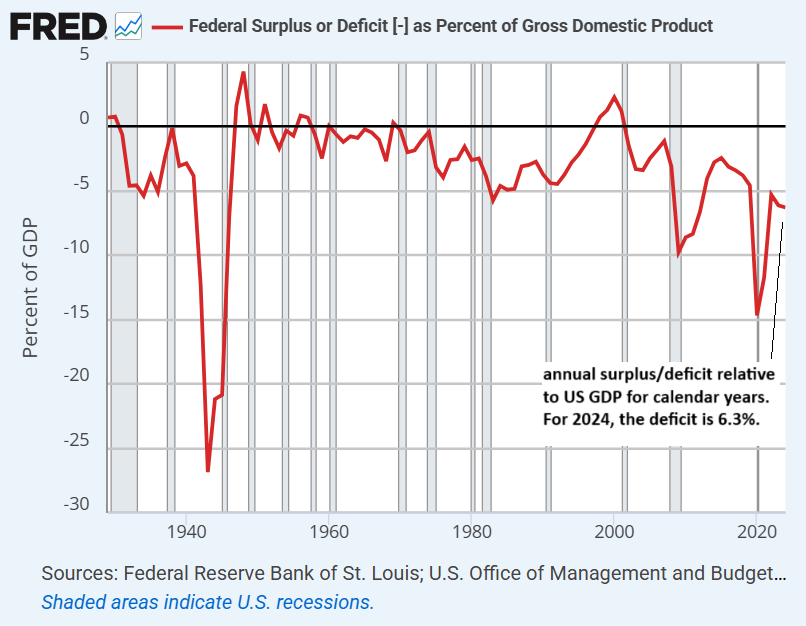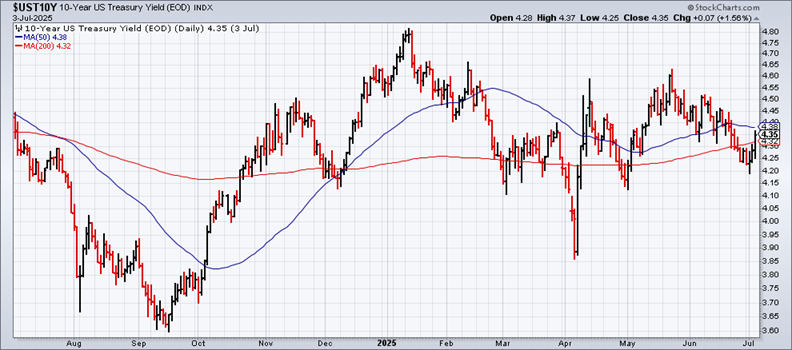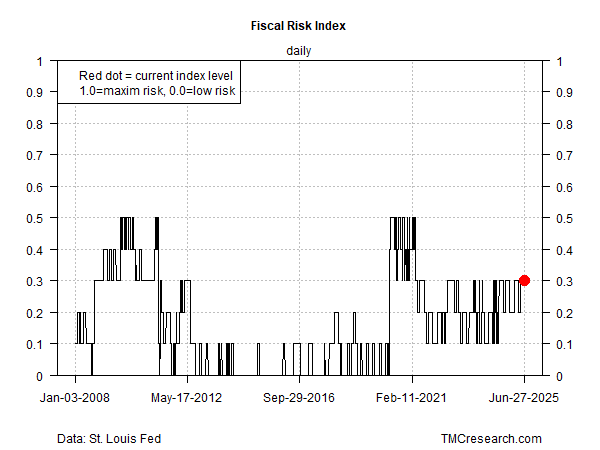The week ahead will provide early clues for two very different risk factors looming for the bond market.
On the one hand, the on-again/off-again risk of tariffs is lurking – a development that could create new economic headwinds that soften growth and, in theory, lower interest rates as investors seek safe havens and the eases its policy stance to provide stimulus.
But tariffs could also lift inflation, perhaps persuading the Fed to keep rates higher for longer if not raise rates. Deciding which aspect of the tariff effect will dominate is tricky for several reasons, including ongoing ambiguity about when or if tariffs will change and uncertainty about the macro price tag associated with raising import costs.
Another complicating factor for the bond market: renewed expectations that the already hefty federal budget deficit will deepen after President Trump last week signed his mega spending bill, which is projected to increase red ink by $4 trillion+ for the next decade, according to the Penn Wharton Budget Model.
The Budget Lab at Yale anticipates a somewhat lesser $3 trillion increase in the deficit over the next ten years. In theory, a deeper deficit implies higher Treasury yields as markets demand greater compensation for the risk.
What is beyond dispute is that the fiscal stakes are high given that the US deficit already exceeds 6% of GDP, which is roughly 63% more than the average for the past 50 years.
How will the bond market price in these risks? At the moment, it appears that sentiment is in a holding pattern.
The benchmark closed higher last week, settling at 4.35% and marking the first weekly increase in a month. Relative to the year so far, however, the current 10-year rate remains middling.
The week ahead could be useful for deciding how the bond market will react to the conflicting risks of potentially slowing growth vs. a deepening budget deficit. Each implies a different yield path – lower vs. higher, respectively.
Bond market doves point to expectations that the central bank remains on track to start cutting interest rates, perhaps as early as September. But Friday’s better-than-expected payrolls increase in June gave the market a new reason to doubt the timing of the next rate cut on the assumption that if the labor market remains resilient, the pressure lessens for trimming rates.
Tariffs could be a complicating factor, however. US consumers say they’ll cut back on spending this summer as tariff worries weigh on the outlook, according to a new Yahoo Finance/Marist Poll.
Roughly 80% of Americans surveyed expressed some level of concern that tariffs will impact their personal finances, which in turn is influencing spending plans. On that basis, economic growth could weaken more than the June payrolls data imply, which in turn suggests that a Fed rate cut could be near after all.
But now that the massive spending bill has become law, traders are wondering if the bond market will begin pricing in a deeper level of budget-deficit risk – a risk that suggests investors will demand a higher yield as compensation for the expected runup in fiscal risk.
As I discussed last week, a measure of fiscal risk has remained steady recently. A key question is whether this risk changes now that the spending bill has become the law of the land.
Tariffs will probably soak up most of the bandwidth this week as markets focus on the July deadline for trade deals. Countries that don’t reach a new deal with the US face an increase in import fees. More than a dozen nations could receive letters announcing higher tariffs, the President said on Sunday. But as The Wall Street Journal reports:
Treasury Secretary Scott Bessent said on CNN’s “State of the Union” on Sunday that the tone of the letters being sent might not be a declaration of immediate tariffs on dozens of countries. Instead, Bessent said, the letters will feature another deadline that trading partners will have to meet to come to a deal with the U.S. to avoid the same so-called reciprocal duties originally announced in April.
“President Trump is going to send letters to some of our trading partners saying that ‘if you don’t move things along, then on August 1st, you will boomerang back to your April 2nd tariff level,’” Bessent said.
Deciding how the bond market will price in these risks is anyone’s guess. The Capital Spectator expects the 10-year yield to trade in a relatively narrow range for the near term as the competing forces offset one another until one side or the other dominates trading sentiment. But as always, we reserve the right to change our view in a heartbeat, depending on what we learn from a certain social media account in the hours and days ahead.
